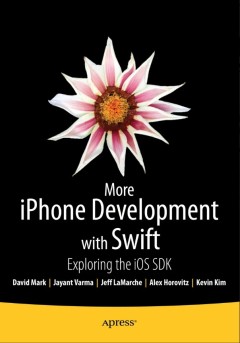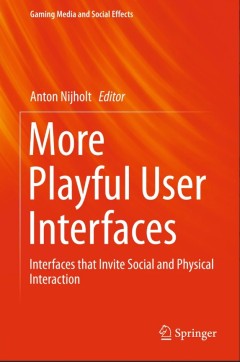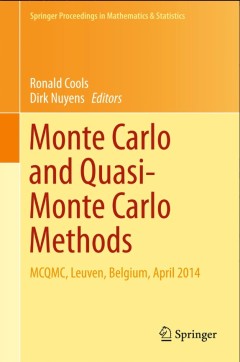Filter by

More iPhone Development with Swift
Interested in iPhone and iPad apps development? Want to learn more? Whether you are a relative newcomer to iPhone and iPad or iOS development or an old hand looking to expand your horizons, we have the perfect Swift-flavored book for you. The update to the bestselling More iPhone Development by Dave Mark and Jeff LaMarche, More iPhone Development with Swift digs deeper into the new Apple Swift…
- Edition
- 8
- ISBN/ISSN
- 978-1-4842-0449-8
- Collation
- -
- Series Title
- -
- Call Number
- -

More iPhone Development with Objective-C
If you are looking to extend your iOS programming skills beyond the basics then More iPhone Development with Objective-C is for you. Authors Dave Mark, Jayant Varma, Jeff LaMarche, Alex Horovitz, and Kevin Kim explain concepts as only they can—with code snippets you can customize and use, as you like, in your own apps. More iPhone Development with Objective-C is an independent companion to B…
- Edition
- 3
- ISBN/ISSN
- 978-1-4302-6037-0
- Collation
- -
- Series Title
- -
- Call Number
- -

More Playful User Interfaces
This book covers the latest advances in playful user interfaces – interfaces that invite social and physical interaction. These new developments include the use of audio, visual, tactile and physiological sensors to monitor, provide feedback and anticipate the behavior of human users. The decreasing cost of sensor and actuator technology makes it possible to integrate physical behavior inform…
- Edition
- 1
- ISBN/ISSN
- 978-981-287-546-4
- Collation
- -
- Series Title
- Gaming Media and Social Effects
- Call Number
- -

Organic Cation Transporters : Integration of Physiology, Pathology, and Pharm…
This innovative text explores the cellular transport of organic cations, from functional and structural properties to pharmacological implications and psychiatric developments. The authoritative chapters introduce organic cation transporters and then proceed to discuss their mechanisms such as binding of substrates and inhibitors; their drug dispositions and toxicity; their relationships to gen…
- Edition
- -
- ISBN/ISSN
- 978-3-319-23793-0
- Collation
- -
- Series Title
- -
- Call Number
- 541.372 ORG

Modeling in Biopharmaceutics, Pharmacokinetics and Pharmacodynamics
The state of the art in Biopharmaceutics, Pharmacokinetics, and Pharmacodynamics Modeling is presented in this new second edition book. It shows how advanced physical and mathematical methods can expand classical models in order to cover heterogeneous drug-biological processes and therapeutic effects in the body.The book is divided into four parts; the first deals with the fundamental principle…
- Edition
- 2
- ISBN/ISSN
- 978-3-319-27596-3
- Collation
- XXII, 483
- Series Title
- Interdisciplinary Applied Mathematics
- Call Number
- -

Modern Technologies for Landslide Monitoring and Prediction
Modern Technologies for Landslide Investigation and Prediction presents eleven contributed chapters from Chinese and Italian authors, as a follow-up of a bilateral workshop held in Shanghai on September 2013. Chapters are organized in three main parts: ground-based monitoring techniques (photogrammetry, terrestrial laser scanning, ground-based InSAR, infrared thermography, and GNSS networks), g…
- Edition
- 1
- ISBN/ISSN
- 978-3-662-45930-0
- Collation
- XII, 249
- Series Title
- Springer Natural Hazards
- Call Number
- -

Emerging Research in Computing, Information, Communication and Applications …
This proceedings volume covers the proceedings of ERCICA 2015. ERCICA provides an interdisciplinary forum for researchers, professional engineers and scientists, educators, and technologists to discuss, debate and promote research and technology in the upcoming areas of Computing, Information, Communication and their Applications. The contents of this book cover emerging research areas in field…
- Edition
- -
- ISBN/ISSN
- 978-981-10-0287-8
- Collation
- 111 b/w illustrations, 269 illustrations in colour
- Series Title
- -
- Call Number
- -

Monte Carlo and Quasi-Monte Carlo Methods
This book presents the refereed proceedings of the Eleventh International Conference on Monte Carlo and Quasi-Monte Carlo Methods in Scientific Computing that was held at the University of Leuven (Belgium) in April 2014. These biennial conferences are major events for Monte Carlo and quasi-Monte Carlo researchers. The proceedings include articles based on invited lectures as well as carefully s…
- Edition
- 1
- ISBN/ISSN
- 978-3-319-33507-0
- Collation
- XVIII, 622
- Series Title
- Springer Proceedings in Mathematics & Statistics
- Call Number
- -

Emerging Research in Computing, Information, Communication and Applications …
This proceedings volume covers the proceedings of ERCICA 2015. ERCICA provides an interdisciplinary forum for researchers, professional engineers and scientists, educators, and technologists to discuss, debate and promote research and technology in the upcoming areas of Computing, Information, Communication and their Applications. The contents of this book cover emerging research areas in field…
- Edition
- -
- ISBN/ISSN
- 978-81-322-2553-9
- Collation
- 109 b/w illustrations, 257 illustrations in colour
- Series Title
- -
- Call Number
- -

Emerging Research in Computing, Information, Communication and Applications …
This proceedings volume covers the proceedings of ERCICA 2015. ERCICA provides an interdisciplinary forum for researchers, professional engineers and scientists, educators, and technologists to discuss, debate and promote research and technology in the upcoming areas of Computing, Information, Communication and their Applications. The contents of this book cover emerging research areas in field…
- Edition
- -
- ISBN/ISSN
- 978-81-322-2550-8
- Collation
- 87 b/w illustrations, 218 illustrations in colour
- Series Title
- -
- Call Number
- -
 Computer Science, Information & General Works
Computer Science, Information & General Works  Philosophy & Psychology
Philosophy & Psychology  Religion
Religion  Social Sciences
Social Sciences  Language
Language  Pure Science
Pure Science  Applied Sciences
Applied Sciences  Art & Recreation
Art & Recreation  Literature
Literature  History & Geography
History & Geography